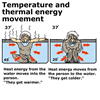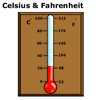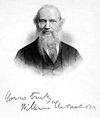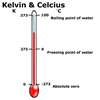You might hear something like "the temperature today will be 26°C" and this gives you some idea of what to expect from past experience. In scientific terms, temperature is a measure of "hotness" or average kinetic energy and is usually measured with a thermometer. Knowing the temperature of an object will tell us something about the way it interacts with its surroundings. If an object is hotter than its surroundings, heat energy will flow from the object to its colder surrounds. If it is colder, then heat energy will flow from the surrounds to the object.
Temperature and heat
 Think about how you can get warm quickly by getting into a hot bath. Your
temperature may be 37°C and the water 45°C. The water, being hotter, transfers
some of its energy into your body until both you and the bath are the
same temperature. Now think about getting into a cold bath. Which way
does the energy go now?
Think about how you can get warm quickly by getting into a hot bath. Your
temperature may be 37°C and the water 45°C. The water, being hotter, transfers
some of its energy into your body until both you and the bath are the
same temperature. Now think about getting into a cold bath. Which way
does the energy go now?
Thermometers and temperature scales
You may already know that there are at least two different temperature
scales used in everyday life, but how did they come about?
Thermometers use the principle that gases and liquids expand as they get hotter and contract as they get colder. This expansion and contraction is caused by the particles moving faster when heated and slower when cooled. As matter is made up of an enormous number of particles the combined result of all this movement is that the liquid or gas expands when heated and contracts when cooled.
![]() The first thermometer was made by Galileo in 1593. It was not very
accurate, but it did show changes in temperature. It wasn't until 1714
that a German physicist, Gabriel Fahrenheit, made a thermometer with mercury
in a small bore glass tube, that an accurate thermometer with a scale
was made. He chose to set his scale using "fixed points". One
point was the lowest temperature he could reach by freezing water saturated
with salt - he called this 0° . The upper fixed point was the human body
temperature which he set (slightly incorrectly as it happens) at 100°.
Having done this, the freezing point of water became 32°F and the boiling
point of water 212°F - both rather odd numbers!
The first thermometer was made by Galileo in 1593. It was not very
accurate, but it did show changes in temperature. It wasn't until 1714
that a German physicist, Gabriel Fahrenheit, made a thermometer with mercury
in a small bore glass tube, that an accurate thermometer with a scale
was made. He chose to set his scale using "fixed points". One
point was the lowest temperature he could reach by freezing water saturated
with salt - he called this 0° . The upper fixed point was the human body
temperature which he set (slightly incorrectly as it happens) at 100°.
Having done this, the freezing point of water became 32°F and the boiling
point of water 212°F - both rather odd numbers!
 A much neater scale was developed in 1742 by a Swedish astronomer
named Anders Celsius. He set the freezing point of pure water at 0° and
the boiling point of pure water, at sea level, as 100°. The scale was
divided into 100 equal divisions, which is why it has been called Centigrade
(divided into 100 parts).
A much neater scale was developed in 1742 by a Swedish astronomer
named Anders Celsius. He set the freezing point of pure water at 0° and
the boiling point of pure water, at sea level, as 100°. The scale was
divided into 100 equal divisions, which is why it has been called Centigrade
(divided into 100 parts).
How low can you get?
The usual temperature scales are fine for everyday use as they cover our
normal range of weather, cooking, heating and so on. However, how cold
is it possible to get?
 Think back to what temperature is; it is a measure of the movement
of particles. As the temperature gets lower, the particles move less quickly.
At some point they should (theoretically!) stop their wholesale movement.
This lowest possible temperature was established by a British physicist
named William Kelvin (Lord Kelvin) in the 1800s.
Think back to what temperature is; it is a measure of the movement
of particles. As the temperature gets lower, the particles move less quickly.
At some point they should (theoretically!) stop their wholesale movement.
This lowest possible temperature was established by a British physicist
named William Kelvin (Lord Kelvin) in the 1800s.
 It is called absolute zero and is -273°C. At this very low temperature
unusual things happen, for example some metals become super conductive
to electricity which has opened up all sorts of possibilities for inventions.
On the Kelvin scale, the degrees sign is not used so the freezing point
of water is 273 K.
It is called absolute zero and is -273°C. At this very low temperature
unusual things happen, for example some metals become super conductive
to electricity which has opened up all sorts of possibilities for inventions.
On the Kelvin scale, the degrees sign is not used so the freezing point
of water is 273 K.
Note:- Modern quantum physics requires that the subatomic particles in atoms must still move even at absolute zero, but the atoms themselves do not move.
Other thermometers
Not all thermometers are made of liquid in glass. With the advent of electronics,
probes are made that give a digital read out. These are much safer for
reading body temperatures as there is no risk of glass breaking and toxic
mercury getting into the patient's mouth.
In furnaces, pyrometers measure temperature. These make use of the fact that very hot steel, for example, emits light, red hot or even white hot. The colour and intensity of the light is an indication of temperature.
| Copyright owned by the State of Victoria (Department of Education and Early Childhood Development). Used with Permission. |